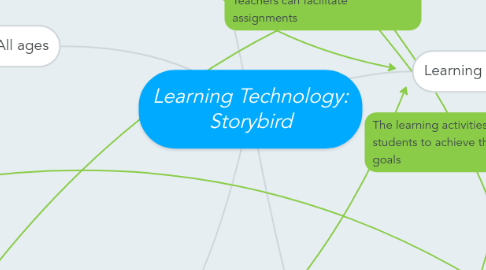
1. Curriculum range: All ages
1.1. There is available literature for all age ranges
1.2. From preschool (1-4) through Adulthood
1.3. Provides literature for all likes and dislikes, along with these age ranges
1.4. Promotes the use of english/grammar for all age ranges and learning levels
2. Teacher Roles
2.1. Determine Learning goals
2.1.1. Create reasonable and achievable goals
2.1.2. Students create their own personal story
2.1.3. Each student can share their story with a classmate
2.1.4. Encourage them to read other stories online
2.1.4.1. Some stories are published on the main website and are available for reading and learning to everyone
2.1.5. Collaborating with other classrooms
2.1.5.1. Students can work together by seeing their classmates stories online and commenting on them
2.2. Facilitate the activities
2.2.1. Make sure they're staying on task
2.2.2. Help out when needed
2.2.3. Give them the tools to complete the project
2.3. Teach a Lesson
2.3.1. Common Core Alignment
2.3.1.1. Writing
2.3.1.1.1. Text Types and Purposes
2.3.1.1.2. Production and Distribution of Writing
2.3.1.1.3. Range of Writing
2.3.1.2. Language
2.3.1.2.1. Conventions of Standard English
2.3.1.2.2. Knowledge of Language
2.3.1.2.3. Vocabulary Acquisition and use
2.3.2. Teach lessons through a Private Classroom without having to use an email
2.3.2.1. Collects no data from students
2.3.2.2. Completely private and all of the former lessons are saved to the Private Classroom
3. Learning activities
3.1. Create
3.1.1. Picture books for K-5
3.1.2. Long-form chapter books for grades 5-9
3.1.3. Poetry for all grades
3.1.4. Build class library
3.2. Discover
3.2.1. Read 15 million+ stories from free library
3.2.2. Follow favorite authors
3.2.3. Class linking: collaborate with other classes
3.3. Learn
3.3.1. Free class tools
3.3.1.1. Issue and manage assignments
3.3.1.1.1. Grade student work
3.3.1.1.2. Virtual stickers and awards
3.3.2. Private classroom
3.3.3. Story review panel
3.3.3.1. Comment moderation panel
3.4. Share
3.4.1. Embed stories
3.4.2. Share work with parents
3.4.3. Print
3.4.3.1. Downloadable PDFs
3.4.3.2. Softcover and hardcover copies
4. Learning Goals
4.1. Inspire
4.1.1. Students to write books
4.1.2. To not limit themselves, with the ability to publish and share their creative pieces
4.2. Encourage
4.2.1. Students to express their words through art
4.2.2. Students to have creative freedom
4.3. Allow
4.3.1. Input to influence stories
4.3.2. Students to expand their literary libraries
4.3.3. Students to take their time, with a feature for extended and short periods of time
4.3.4. An understanding of figurative language, and word relationships
4.4. Provides
4.4.1. Students with the ability to use the internet for research, and the site to share with others
4.5. Why it is used
4.5.1. Create
4.5.1.1. New books
4.5.2. Discover
4.5.2.1. Find your favorite writers
4.5.3. Learn
4.5.3.1. Create Assignments
4.5.3.2. Build a library of stories for the classroom
4.5.4. Connect
4.5.4.1. Writers can connect to their fan base
4.5.5. Sell
4.5.5.1. Writers can sell their work
4.5.6. Enjoy
4.5.6.1. Good activity for the classroom or at home
4.5.6.2. Enjoy reading other people's work or creating your own
5. Learning Assessments
5.1. Writing
5.1.1. Write narratives using effective techniques, details, and well-structured event sequences.
5.1.2. Range of Writing
5.1.2.1. Write routinely over extended and short time frames, with a range of tasks, purposes, and audiences in mind
5.1.3. Produce clear and coherent writing keeping in mind organization, development, and style are appropriate to task, purpose, and audience.
5.2. Language
5.2.1. Knowledge of Language
5.2.1.1. Apply knowledge of language to understand how language functions in different contexts, to make effective choices for meaning or style, and comprehend better with listening and reading.
5.2.2. Conventions of Standard English
5.2.2.1. Demonstrate command of conventions of standard English capitalization, punctuation, and spelling when writing.
5.2.3. Vocabulary and Acquisition Use
5.2.3.1. Demonstrate understanding of figurative language, word relationships, and nuances in word meanings
